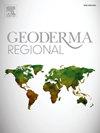亚热带不同耕地利用类型土壤有机碳动态(2008-2020年
IF 3.3
2区 农林科学
Q2 SOIL SCIENCE
引用次数: 0
摘要
土壤有机碳(SOC)改善土壤结构,保持水分,增加养分有效性,从而提高作物生产力,并作为减缓气候变化的重要碳汇。虽然已经提出土地利用方式的改变可以显著影响有机碳的固存,但深入研究不同类型耕地利用方式对有机碳固存的不同影响的研究有限。本研究主要目的是比较福建省84个县(市、区)不同耕地利用类型土壤有机碳动态的差异。本研究利用230,445个实测土壤样本和1:5万高分辨率土壤图谱(省级尺度上同类数据库中最详细的),模拟了2008 - 2020年不同耕地利用类型土壤有机碳动态。通过将该综合数据集与DNDC(反硝化和分解)模型集成,我们的方法提供了更高的空间精度和更强大的模拟。结果表明:耕地、水田、旱地和灌地的年平均固碳率分别为13.16、30.98、- 12.31和- 5.52 kg·ha - 1;耕地和水田土壤有机碳(TΔSOC)变化总量分别为171.06 Gg和402.80 Gg,旱地和灌地土壤有机碳(TΔSOC)变化总量分别为- 160.20 Gg和- 71.72 Gg。13 a来,TΔSOC的年际变化在−263.66 ~ 254.71 Gg之间。所有耕地在2008 - 2016年均为正TΔSOC,而在2017年之后明显转向负值。总体而言,全省耕地表现出适度的碳汇行为。更具体地说,水田是有效的碳汇,而旱地和灌溉地都是碳源。初始有机碳含量高是与dSOC负相关的主要直接因素。降雨通过促进旱地和灌地粘土含量的增加间接降低了dSOC。未来农业管理应在保持经济效益和作物生长的同时,增加水田有机肥的施用;旱地和灌地应同时施用生物炭,实行雨季排水。本文章由计算机程序翻译,如有差异,请以英文原文为准。
Soil organic carbon dynamics (2008–2020) across different cultivated land use types in a subtropical region
Soil organic carbon (SOC) improves soil structure, retains water, and increases nutrient availability, which enhances crop productivity and serves as a significant carbon sink for climate mitigation. While it has been proposed that alterations in land use can significantly influence SOC sequestration, limited research has delved into the distinct impacts of various types of cultivated land use. The main objective of this study was to compare differences in SOC dynamics across diverse cultivated land use types in 84 counties (cities and districts) within Fujian Province, a typical subtropical area of China. This study utilizes 230,445 measured soil samples and a high-resolution 1:50,000 soil map—the most detailed database of its kind applied at the provincial scale—to simulate SOC dynamics under different cultivated land use types from 2008 to 2020. By integrating this comprehensive dataset with the DNDC (Denitrification and Decomposition) model, our approach offers greater spatial precision and more robust simulations. The results indicated that the average annual soil carbon sequestration rate (dSOC) for all cultivated land, paddy fields, dry land, and irrigated land, was 13.16, 30.98, −12.31, and −5.52 kg·ha−1, respectively. The total change of SOC (TΔSOC) values were 171.06 Gg and 402.80 Gg for all cultivated land and paddy fields, while they were −160.20 Gg and −71.72 Gg for dry land and irrigated land, respectively. Over the past 13 years, the interannual variations of TΔSOC reveal a range of −263.66 to 254.71 Gg across all cultivated land in the province. Positive TΔSOC for all cultivated land dominated from 2008 to 2016, while a shift to negative values is apparent after 2017. In general, the cultivated land throughout the province displayed a modest carbon-sink behavior. More specifically, paddy fields functioned as effective carbon sinks, while both dry land and irrigated land behaved as carbon sources. The high initial SOC content is the main direct factor negatively correlated with dSOC. Rainfall indirectly reduces dSOC by promoting an increase in clay content in both dry land and irrigated land. To improve future agricultural management, we should increase the amount of organic fertilizer applied to paddy field while maintaining economic efficiency and crop growth, and apply biochar and implement wet season drainage for both dry and irrigated land.
求助全文
通过发布文献求助,成功后即可免费获取论文全文。
去求助
来源期刊

Geoderma Regional
Agricultural and Biological Sciences-Soil Science
CiteScore
6.10
自引率
7.30%
发文量
122
审稿时长
76 days
期刊介绍:
Global issues require studies and solutions on national and regional levels. Geoderma Regional focuses on studies that increase understanding and advance our scientific knowledge of soils in all regions of the world. The journal embraces every aspect of soil science and welcomes reviews of regional progress.
 求助内容:
求助内容: 应助结果提醒方式:
应助结果提醒方式:


